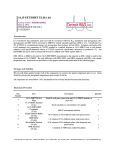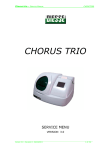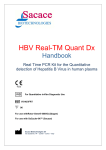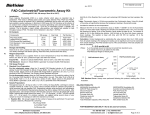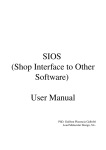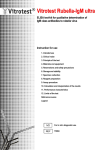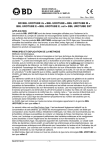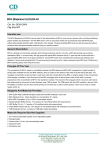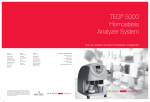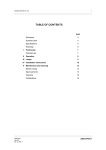Download ab175813 – 14,15 DHET ELISA Kit for Human Urine
Transcript
ab175813 – 14,15 DHET ELISA Kit for Human Urine Instructions for Use A competitive immunoenzymatic assay for the quantitative measurement of free and glucuronidated 14,15 DHET in urine. This product is for research use only and is not intended for diagnostic use. Version 2 Last Updated 2 March 2015 Table of Contents INTRODUCTION 1. BACKGROUND 2. ASSAY SUMMARY 2 3 GENERAL INFORMATION 3. 4. 5. 6. 7. 8. PRECAUTIONS STORAGE AND STABILITY MATERIALS SUPPLIED MATERIALS REQUIRED, NOT SUPPLIED LIMITATIONS TECHNICAL HINTS 4 4 4 5 5 6 ASSAY PREPARATION 9. 10. 11. 12. REAGENT PREPARATION STANDARD PREPARATION SAMPLE COLLECTION AND STORAGE PLATE PREPARATION 7 8 9 13 ASSAY PROCEDURE 13. ASSAY PROCEDURE 14 DATA ANALYSIS 14. 15. 16. CALCULATIONS TYPICAL DATA ASSAY SPECIFICITY 15 16 17 RESOURCES 17. TROUBLESHOOTING 18. NOTES 18 20 Discover more at www.abcam.com 1 INTRODUCTION 1. BACKGROUND Abcam's 14,15 DHET competitive in vitro ELISA Kit for Human Urine is designed for determination of free and glucuronidated 14,15 DHET levels in urine. This competitive ELISA kit is based on competition between the 14,15 DHET epitope and the 14,15 DHET-HRP conjugate for a limited number of binding sites available from the anti-14,15 DHET antibody; which is coated to the wells of the 96 well ELISA plate. The conjugate concentration is held as a constant in each well, while the concentration of the 14,15 DHET is variable, based on the concentration of the sample or standard. Thus the amount of the 14,15 DHET conjugate which is able to bind to each of the wells is inversely proportional to the concentration of 14,15 DHET in the standard or sample. The amount of the conjugate which is bound to each well is then determined by the amount of color obtained, when TMB is added. The TMB reacts with the HRP available in the well. With the addition of sulfuric acid, the blue colored product is converted into a yellow colored product, which can be read on a plate reader at 450 nm. The 14,15 DHET is a representative metabolite of soluble epoxide hydrolase-mediated metabolism of EETs, which are generated by arachidonic acid epoxygenase activity of cytochromes P450. 14,15 DHET level exhibited strong positive correlation with hypertension in rat and human and brain injury and stroke in rodents. High levels of the glucuronidated form of 14,15 DHET have been found in human urine but not in urine collected from rodents. Discover more at www.abcam.com 2 INTRODUCTION 2. ASSAY SUMMARY Prepare all reagents and samples as instructed. Add standards and samples to each well used. Add prepared HRP conjugate to each well and incubate at room temp. Add TMB substrate to each well. Incubate at room temperature. Add Stop Solution to each well. Read immediately. Discover more at www.abcam.com 3 GENERAL INFORMATION 3. PRECAUTIONS Please read these instructions carefully prior to beginning the assay. All kit components have been formulated and quality control tested to function successfully as a kit. Modifications to the kit components or procedures may result in loss of performance. 4. STORAGE AND STABILITY Store kit at 2-8°C or -20°C immediately upon receipt. Refer to list of materials supplied for storage conditions of individual components. Observe the storage conditions for individual prepared components in section 9. Reagent Preparation. 5. MATERIALS SUPPLIED 96 Wells Storage Condition (After Preparation) 2-8°C 2 µL 2-8°C 1,000X 14,15 DHET HRP Conjugates 12 µL 2-8°C 10X Sample Dilution Buffer 25 mL 2-8°C HRP Buffer 15 mL 2-8°C 10X Wash Buffer Solution 25 mL 2-8°C TMB Substrate 24 mL 2-8°C Beta-Glucuronidase enzyme 8 mg 2-8°C Item 14,15 DHET ELISA plate 14,15 DHET Standard (1 mg/mL) Discover more at www.abcam.com Amount 4 GENERAL INFORMATION 6. MATERIALS REQUIRED, NOT SUPPLIED These materials are not included in the kit, but will be required to successfully utilize this assay: Microplate reader capable of measuring absorbance at 450 nm Incubator at 37°C Multi- and single-channel pipettes to deliver volumes between 10 and 1,000 µL Optional: Automaticplate washer for rinsing wells. Storage bottles Rotating mixer Deionised or (freshly) distilled water. Disposable tubes Timer 2N Sulfuric acid 1M Citric acid 7. LIMITATIONS ELISA kit intended for research use only. Not for use in diagnostic procedures Use only clean pipette tips, dispensers, and lab ware Do not interchange screw caps of reagent vials to avoid crosscontamination Close reagent vials tightly immediately after use to avoid evaporation and microbial contamination After first opening and subsequent storage check conjugate and control vials for microbial contamination prior to further use To avoid cross-contamination and falsely elevated results pipette patient samples and dispense conjugate, without splashing, accurately to the bottom of wells Discover more at www.abcam.com 5 GENERAL INFORMATION 8. TECHNICAL HINTS Avoid foaming components Avoid cross contamination of samples or reagents by changing tips between sample, standard and reagent additions Ensure plates are properly sealed or covered during incubation steps Complete removal of all solutions and buffers during wash steps is necessary for accurate measurement readings Addition of the TMB Substrate solution initiates a kinetic reaction, which is terminated by the addition of the Stop Solution. Therefore, the TMB Substrate and the Stop Solution should be added in the same sequence to eliminate any time deviation during the reaction It is important that the time of reaction in each well is held constant for reproducible results. Pipetting of samples should not extend beyond ten minutes to avoid assay drift. If more than 10 minutes are needed, follow the same order of dispensation. If more than one plate is used, it is recommended to repeat the dose response curve in each plate The incomplete or inaccurate liquid removal from the wells could influence the assay precision and/or increase the background This kit is sold based on number of tests. A ‘test’ simply refers to a single assay well. The number of wells that contain sample, control or standard will vary by product. Review the protocol completely to confirm this kit meets your requirements. Please contact our Technical Support staff with any questions or bubbles Discover more at www.abcam.com when mixing or reconstituting 6 ASSAY PREPARATION 9. REAGENT PREPARATION Equilibrate all reagents, samples and controls to room temperature (18-25°C) prior to use. 9.1 1X Wash Buffer Mix the 10X Wash Buffer Solution with a stir bar, applying low, gentle heat until a clear colorless solution is obtained. Dilute the entire contents of the 10X Wash Buffer Solution (25 mL) with 225 mL of deionized water to yield a final volume of 250 mL of 1 X Wash Buffer. This can then be refrigerated for the entire life of the kit. 9.2 1X HRP Conjugate Dilute 1 vial of the 14,15 DHET-HRP conjugate (12 µL) with 12mL of HRP Buffer. One vial makes enough conjugate for one plate. The conjugate must be used the same day and should not be stored for later use. 9.3 1X Sample Dilution Buffer Prepare 1X Sample Dilution Buffer by adding 25 mL of 10X Sample Dilution Buffer to 225 mL of dH20. Mix gently and thoroughly. Discover more at www.abcam.com 7 ASSAY PREPARATION 10. STANDARD PREPARATION Prepare serially diluted standards immediately prior to use. Always prepare a fresh set of positive controls for every use. 10.1 Label 5 microtubes as Standard # 2 - 6. 10.2 Add 900µL of the 1X Sample Dilution Buffer to the microtubes for Standards # 2 to 6. 10.3 Prepare a 1 µg/mL Standard #1 by first spinning down the enclosed 14,15 DHET standard vial (2 μL, filled with inert gas) and then adding 1.998 mL of 1X Sample Dilution Buffer to obtain 2 mL of solution. 10.4 Prepare Standard #2 by adding 100µL of the Standard #1 to the microtube labeled Standard #2. Mix thoroughly and gently. 10.5 Prepare Standard #3 by adding 100µL of the Standard #2 to the microtube labeled Standard #3. Mix thoroughly and gently. 10.6 Using the table below as a guide, repeat for tubes #4 through #6. 10.7 Standard Bo contains no protein and is blank control. Standard # Sample Dilute to 1 2 3 4 5 6 Bo Step 10.3 Standard #1 Standard #2 Standard #3 Standard #4 Standard #5 None Volume to Dilute (µL) 100 100 100 100 100 Discover more at www.abcam.com Volume of Diluent (µL) Starting Conc. (pg/mL) Final Conc. (pg/mL) 900 900 900 900 900 900 1,000,000 100,000 10,000 1,000 100 - 1,000,000 100,000 10,000 1,000 100 10 - 8 ASSAY PREPARATION 11. SAMPLE COLLECTION AND STORAGE There are different protocols for isolating and purifying 14,15 DHET depending on the medium in which it is in. For optimal results follow the appropriate protocol based on the biological sample present. Dissolve 8 mg of Beta-Glucuronidase in 8 mL of 1 M Citric acid and adjust to pH 5.5 (400 U/mL). 11.1 Measurement of free and glucuronidated 14,15 DHET in sample extraction with ethyl acetate. 11.1.1 Measurement of free 14,15 DHET: Extract 4 mL of urine with ethyl acetate using the Extraction Protocol described in 11.1.4 below. 11.1.2 Measurement of free and 14,15 DHET glucuronide: This method is for determining the level of glucuronidated 14,15 DHET in urine after digestion of the molecule with glucuronidase. Collect the first sample as soon as the BetaGlucuronidase is added to a reaction mixture (0 hour digestion) and then a second sample at a time when digestion of the glucuronic acid moiety of the molecule is completed. Subtract the level of the molecule in the first sample at 0 hour from the levels in the second sample after complete digestion (usually 3 hrs) to obtain the level of glucuronidated molecule. Discover more at www.abcam.com 9 ASSAY PREPARATION 11.1.3 Beta-Glucuronidase digestion: 11.1.3.1 To 4 mL of urine add 1 mL of the BetaGlucuronidase solution, pH 5.5, to each tube (pH < 6.0). 11.1.3.2 Immediately transfer 2 mL of urine to a clean tube and flash-freeze. This is the zero time point. 11.1.3.3 Incubate the remaining 2 mL at 37°C for 3 hours. This is the 3 hour time point. 11.1.3.4 Extract. 11.1.4 Extraction protocol: 11.1.5 Combine an equal amount of urine sample from steps 11.1.3.2 (Zero time point) and 11.1.3.3 (3 hour time point) above (adjusted with approximately 20 μL of acetic acid to pH 4) and ethyl acetate. Vortex thoroughly. Centrifuge at 2000 rpm for ten minutes at 22°C. Three phases should result: 11.1.6 Upper organic phase – ethyl acetate phase (lipoproteins). 11.1.7 Interphase – proteins. 11.1.8 Lower phase – aqueous phase. 11.1.9 Collect the upper organic phase (a) and set aside. 11.1.10 Discard the interphase. Transfer the lower phase with a glass pipette to a new tube and repeat the ethyl acetate extraction step two more times. 11.1.10.1 Evaporation of pooled organic phase: There should be approximately 5-6 mL of the ethyl acetate phase (a). Dry the pooled organic phase in a Speedvac to get the extracted sediment (b). 11.1.10.2 Saponification (to cleave fatty acid from glycerol backbone): Dissolve the dried residues (b) in 2 mL of 20% KOH solution (for preparation see 14,15 DHET measurement in cells). Vortex Discover more at www.abcam.com 10 ASSAY PREPARATION thoroughly and incubate for 1 h at 50°C. This will yield an aqueous solution (c).Vortex and incubate for 1 h at 50°C.This will yield an aqueous solution (c). 11.1.10.3 Dilute 2 mL of the aqueous solution (c) with 3 mL of H2O. Adjust the pH using 20% formic acid (132 μL) to pH~5.5. Add ethyl acetate (1 part aqueous solution (c) + 1 part ethyl acetate), vortex thoroughly, and centrifuge at 2000 rpm for ten minutes at 22°C. Repeat the procedure twice more using an equal volume of ethyl acetate per sample. Collect the upper phase containing saponified lipids. 11.1.10.4 Dry the pooled ethyl acetate upper phase (d) and dry in a Speedvac, yielding the dried samplesediment (e). Store the sediment (e) at -20°C. For ELISA assay, dissolve the sediment (e) in 20 μL of DMF or ethanol, then add 130 μL of 1X Sample Dilution Buffer. 11.1.10.5 For the competitive 14,15 DHET ELISA, the above 150 μL sample needs to be further diluted: Dilute 1:4 (e.g., 80 μL sample + 320 μL 1x Sample Dilution Buffer). Check the final pH (should be pH 7.4). When calculating the final concentration, consider all dilution factors. 11.1.10.6 Perform the ELISA for 14,15 DHET. 11.2 Measurement of Free and Glucuronidated 14,15 DHET without extraction 11.2.1 Measurement of free 14,15 DHET: Dilute 1 mL urine 4-fold with 1X Sample Dilution Buffer and apply to ELISA plate (100 µL/well). A 4X dilution is recommended although other dilution factors may be tried, too. Discover more at www.abcam.com 11 ASSAY PREPARATION 11.2.2 Measurement of glucuronidated 14,15 DHET: This method is for determining the level of glucuronidated 14,15 DHET in urine after digestion of the molecule with glucuronidase. Collect the first sample as soon as the Beta-Glucuronidase is added to a reaction mixture (0 hour digestion) and then a second sample at a time when digestion of the glucuronic acid moiety of the molecule is completed. Subtract the level of the molecule in the first sample at 0 hour from the levels in the second sample after complete digestion (usually 3 hrs) to obtain the level of glucuronidated molecule. 11.2.3 Beta-Glucuronidase digestion: 11.2.3.1 Dilute 1 mL of urine 4-fold with 1X Sample Dilution Buffer. 11.2.3.2 To 4 mL of urine add 1 mL of the BetaGlucuronidase solution, pH 5.5, to each tube (pH < 6.0). 11.2.3.3 Immediately transfer 2 mL of urine to a clean tube and flash-freeze. This is the Zero time point. 11.2.3.4 Incubate the remaining 2 mL at 37oC for 3 hours. This is the 3 hour time point. 11.2.3.5 Follow the instructions for the ELISA kit. 11.2.3.6 To calculate the amount of glucuronidated 14,15 DHET, subtract the Zero time value from the 3 hour value. Discover more at www.abcam.com 12 ASSAY PREPARATION 12. PLATE PREPARATION The 96 well plate included with this kit are supplied ready to use. It is not necessary to rinse the plate prior to adding reagents Unused well strips should be returned to the plate packet and stored at 4°C For each assay performed, a minimum of 2 wells must be used as a blank, omitting sample and conjugate from well addition. Another 2 wells must be used for a maximum binding control For statistical reasons, we recommend each standard and sample should be assayed with a minimum of two replicates (duplicates) Discover more at www.abcam.com 13 ASSAY PROCEDURE 13. ASSAY PROCEDURE Equilibrate all materials and prepared reagents to room temperature prior to use Please read the test protocol carefully before performing the assay. Result reliability depends on strict adherence to the test protocol as described If performing the test on anautomatic ELISA system we recommend increasing the washing steps from three to five and the volume of 1X Wash Bufferfrom 300 µL to 350 µL to avoid washing effects Assay all standards, controls and samples in duplicate 13.1 Add 200 µL of 1X Sample Dilution Buffer into the blank wells and 100 µL of1XSample Dilution Buffer into maximum binding control wells. 13.2 Add 100 µL of each of the standards or samples into the appropriate wells. 13.3 Add 100 µL of the 1X-HRP conjugate in the all wells except the blank control wells. 13.4 Incubate the plate at room temperature for two hours. 13.5 Wash the plate three times with 400 µLof 1X Wash Buffer per well. 13.6 After the last of the three wash cycles pat the inverted plate dry onto some paper towels. 13.7 Add 200 µL of the TMB substrate to all of the wells. 13.8 Incubate the plate at room temperature for 15-30 minutes. 13.9 Add 50 µL of 2 N sulfuric acid to all of the wells. 13.10 Read the plate at 450 nm. Discover more at www.abcam.com 14 DATA ANALYSIS 14. CALCULATIONS If data redaction software is not available on your plate reader then the results can be obtained manually as follows: 14.1 Average the absorbance (Abs) readings from the blank wellsand subtract that value from each well of the plate to obtain the corrected readings. (Note: Some plate readers do this automatically. Consult the user manual of your plate reader.) 14.2 Average the corrected absorbance readings from the maximum binding control wells. This is your maximum binding. 14.3 Calculate the % Abs for Standard 1 by averaging the corrected absorbance of the two wells; divide the average by the Maximum Binding Control well average absorbance, then multiply by 100. Repeat this formula for the remaining standards. 14.4 Plot the % Abs versus the concentration of 14,15 DHET from the standards using semi-log paper. 14.5 Calculate the % Abs for the samples and determine the concentrations, utilizing the standard curve. 14.6 Multiply the concentrations obtained for each of the samples by their corresponding dilution factor. Discover more at www.abcam.com 15 DATA ANALYSIS 15. TYPICAL DATA TYPICAL STANDARD CURVE – Data provided for demonstration purposes only. A new standard curve must be generated for each assay performed. The data shown here is an example of typical results obtained using the Abcam’s14,15 DHET ELISA kit. These results are only a guideline, and should not be used to determine values from your samples. Conc. (pg/mL) % (B/B0) 10 85.4 100 68.2 1,000 10,000 100,000 1,000,000 47.3 27.9 11.0 5.4 Discover more at www.abcam.com 16 DATA ANALYSIS 16. ASSAY SPECIFICITY The specificity of the 14,15 DHET ELISA was investigated using authentic 14,15 DHET and a panel of eiconsanoids. Eiconsanoid 14,15 DHET 8,9-DHET 11,12-DHET 14,15-EET 15(s) HETE 8,9-EET 5(s)15(s)DiHETE 11,12-EET Arachidonic Acid 5,6-DHET 5,6-EET Reactivity 100.00% 3.30% 3.30% 1.5 % 1.00% 0.40% 0.20% 0.05% 0.05% 0.02% 0.02% Thromboxane B2 0.02% PGE2 <0.01 % PGF2a <0.01 % 6-keto-PGF1a <0.01 % SENSITIVITYThe calculated minimal detectable (MDD) dose is 3 pg/mL.The MDD was determined by calculating the mean of zero standard replicates. Discover more at www.abcam.com 17 RESOURCES 17. TROUBLESHOOTING Problem No color present in standard wells No color in any wells Cause Solution The HRP conjugate was not added Redo the assay and add the conjugate at the proper step The HRP conjugate was not incubated for the proper time Redo the assay and incubate for the proper time The TMB substrate was not added Add substrate The TMB conjugate was not incubated for the proper time Continue incubation until desired color is reached Discover more at www.abcam.com 18 RESOURCES Problem The color is faint The background color is very high Scattered OD obtained from sample Cause One or all of the incubation times were cut short Solution Redo the assay with the proper incubation times The TMB substrate was not warmed up to room temperature Redo the assay making sure all reagents are at room temperature The lab is too cold Be sure the lab temperature is between 21-27°C and redo the assay The TMB substrate has been contaminated Redo the assay with a fresh bottle of substrate Incorrect loading of samples Redo assay using an 8 channel pipetman making sure the 8 channels are equal volume while loading Discover more at www.abcam.com 19 RESOURCES 18. NOTES Discover more at www.abcam.com 20 RESOURCES Discover more at www.abcam.com 21 RESOURCES Discover more at www.abcam.com 22 UK, EU and ROW Email: [email protected] | Tel: +44-(0)1223-696000 Austria Email: [email protected] | Tel: 019-288-259 France Email: [email protected] | Tel: 01-46-94-62-96 Germany Email: [email protected] | Tel: 030-896-779-154 Spain Email: [email protected] | Tel: 911-146-554 Switzerland Email: [email protected] Tel (Deutsch): 0435-016-424 | Tel (Français): 0615-000-530 US and Latin America Email: [email protected] | Tel: 888-77-ABCAM (22226) Canada Email: [email protected] | Tel: 877-749-8807 China and Asia Pacific Email: [email protected] | Tel: 108008523689 (中國聯通) Japan Email: [email protected] | Tel: +81-(0)3-6231-0940 www.abcam.com | www.abcam.cn | www.abcam.co.jp Copyright © 2013 Abcam, All Rights Reserved. The Abcam logo is a registered trademark. All information / detail is correct at time of going to print. RESOURCES 23

























